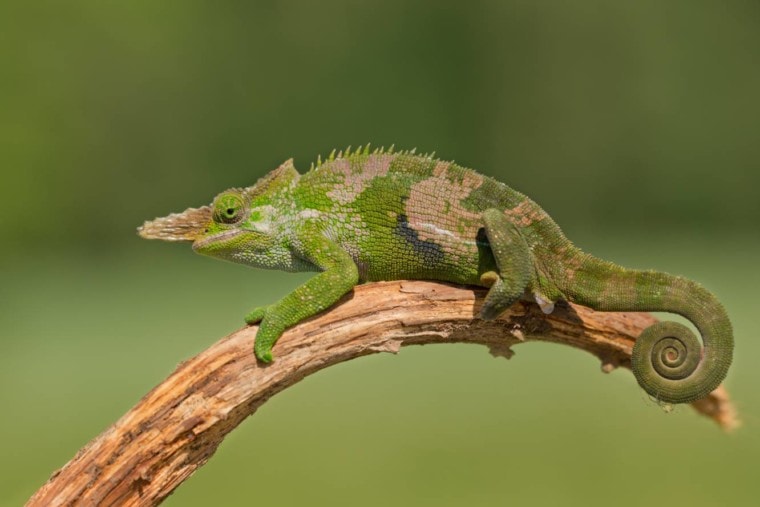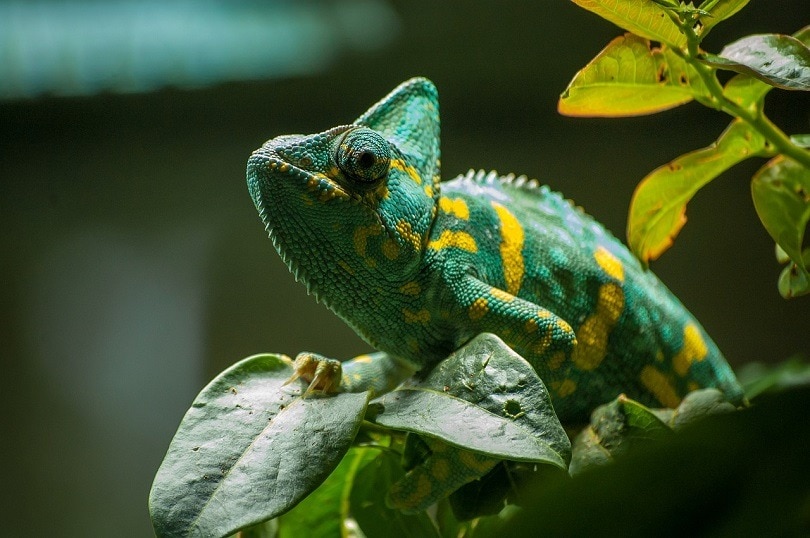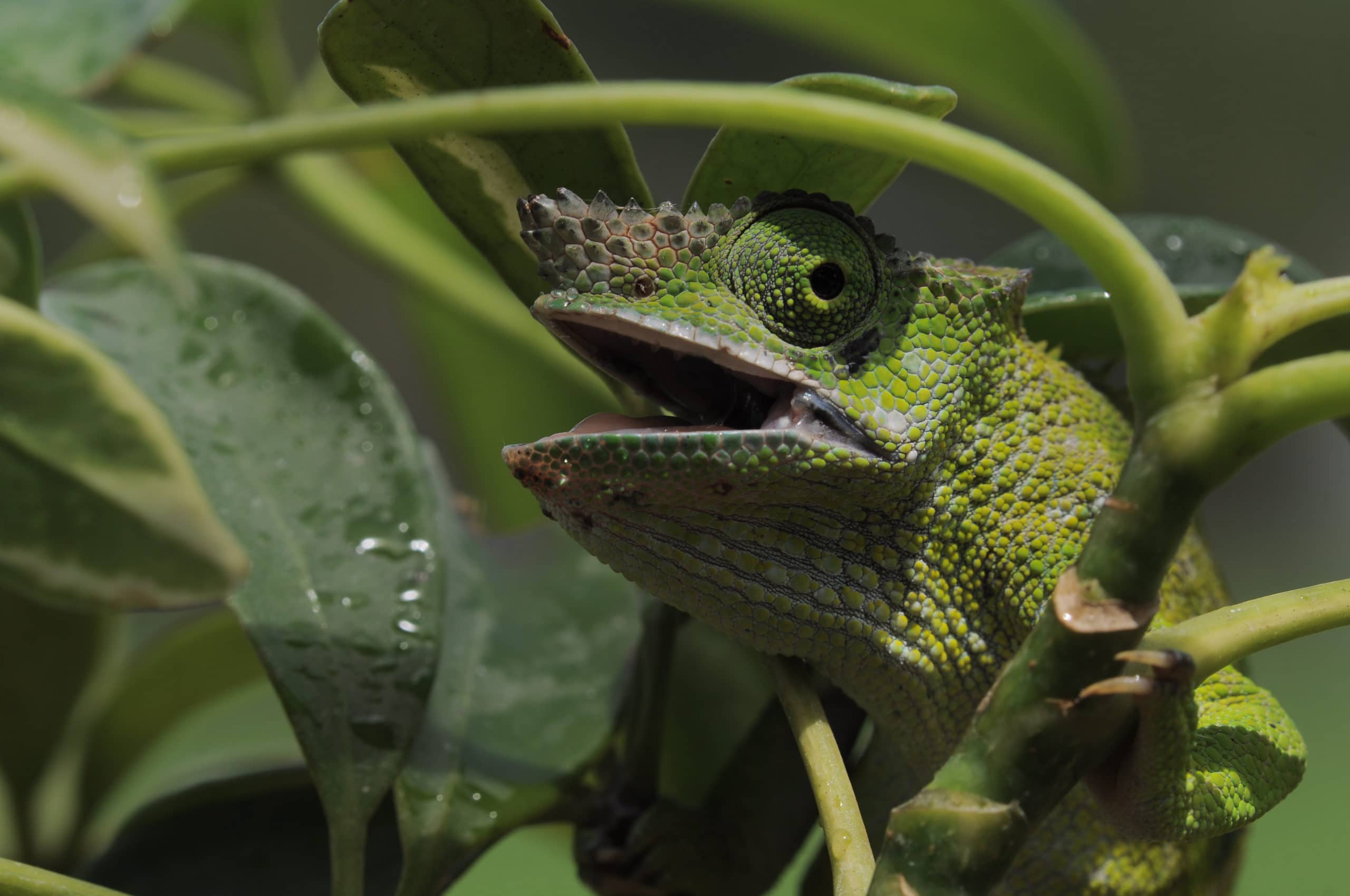
The Chameleon family contains many different species, all of which live somewhere different. Typically, people imagine a tropical rainforest when they think of chameleons. However, these lizards also live in many other places. For instance, you can find chameleons in scrub savannas, deserts, and even mountains.
Most chameleons are native to Africa and they live much of their lives in trees. They are arboreal, which means that they rarely touch the ground. For most chameleons, being on the ground is a death sentence. However, there are a few species that travel to the ground occasionally.
Some species prefer to live in grass and fallen leaves, for instance. The Namaqua chameleon from Africa digs holes in dunes to escape extreme temperatures.
Since there are so many chameleon species around the world, it is difficult to lay out exactly where the chameleon lives. There are just so many of them!
A Chameleon’s Range and Natural Habitat

Chameleons are mostly native to Africa, particularly the forests and deserts. However, these animals are adaptable and can live in a wide range of different environments.
They are also found on the island of Madagascar. Up to 50% of the world’s chameleons are found in Madagascar, over one hundred and fifty species. While the island is known as being heavily forested, it also has deserts and a range of other habitats.
Strangely, most of the island’s chameleons are forest floor dwellers, while those on mainland Africa are arboreal. Likely, the island’s chameleons evolved separately from those on mainland Africa.
There is one species in southern Europe, around Spain, Italy, and Greece, called the Mediterranean chameleon.
Some chameleons also live in the Middle East, southern India, Sir Lanka, and a few smaller islands in the Indian Ocean. The so-called Indian chameleon lives in Sri Lanka!
Those chameleons that don’t spend all their time in trees often live in leaf litter on the ground. Quite a few species are terrestrial, such as the Namaqua chameleon, which lives in the arid Namib Desert in Africa.
Terrestrial chameleons can be found in a variety of different climates. Most often, they are located in tropical areas, such as mountain rainforests. However, they can also be found in savannas, deserts, and steppes.
In their natural habitats, many chameleons are threatened by extinction. For the most part, this is due to habitat loss.
Do Chameleons Live in the United States?

No, chameleons are considered a non-native species to the U.S. However, invasive chameleons have shown up in some states, such as in Florida. Over time, captive chameleons were introduced to this area, where many of them have thrived without natural predators. Nowadays, it isn’t odd to find these chameleons on branches in certain warmer areas.
Since chameleons aren’t native to the country, they are not protected under any state or federal laws. It isn’t odd for “herpers” (people who search for amphibians or reptiles) to find and rescue chameleons released in these areas.
That said, the green anole is native to the United States. This species is sometimes called the “American Chameleon,” but it isn’t technically a chameleon at all.
Where Do Chameleons Live in the U.S.?

You can find chameleons in the more tropical areas of Florida. These lizards are not native to the state but were pets that escaped or were released into the wild. Many thrive in Florida due to the tropical climate.
Many chameleon species are breeding in different parts of Florida. Breeding is a sign that they have a stable and growing population, indicating that they have adapted to their environment.
So far, chameleons have not had a huge impact on the local, native populations in these areas. They seem to eat mostly agricultural pests, like caterpillars, and other nonnative reptiles. However, they may start consuming more native species as their population grows.
Veiled chameleons have been introduced to Hawaii. There, they have begun to pose a threat to native species, especially birds, insects, and certain plants. This species has a high reproductive rate, which enables them to spread quickly.
Some isolated pockets of chameleons are also found in Texas, though they are not nearly as common as they are in Florida. Some have also been reported in California.
These lizards can also tolerate a wide range of environmental conditions. Therefore, it is easier for them to adapt to climates outside their normal range.
Are Chameleons Found in Australia?
Chameleons are not native to Australia. However, some species have been released and have since adapted to the country. For this reason, there are a few isolated pockets of breeding populations.
Like all invasive species, these chameleons may harm the native populations because they have not adapted to handle these predators.
Why Are Chameleons Illegal?

In some areas, chameleons are illegal to own. Sometimes, this is because released pets can harm the native ecosystem. Other times, it’s because the country has ruled that the chameleon trade is threatening chameleons, which are already under threat of extinction.
For instance, the veiled chameleon’s hunting patterns have been shown to interrupt the native species of Hawaii. The species has also been established as a “serious” establishment risk.
Chameleons are known to carry various parasites. They can potentially pass these parasites onto people and native species.
Managing pest populations of chameleons is difficult. The only effective removal method is to actually locate and physically remove them. However, chameleons are difficult to locate due to their camouflage abilities. They also spend much of their time in trees, making them difficult to reach.
In Australia, it is illegal to keep a chameleon as a pet. For the most part, this is due to the potential threat that the species poses to native wildlife.
Final Thoughts
For the most part, chameleons are native to Africa and the island of Madagascar. Most of the world’s chameleons are found in Madagascar, which hosts over 150 different species.
However, there are also a few species native to other parts of the world, such as southern Europe and parts of Asia.
That said, invasive populations have also been set up in areas throughout the world. Hawaii and Florida are likely the most extreme examples of this, but populations have also been reported in Australia, which currently bans the ownership of chameleons.
Most of these invasive populations are caused by released pets. The climate in Florida and Hawaii just happens to be perfect for many chameleon species, so they have spread and established breeding populations.
Featured Image Credit: Milan Zygmunt, Shutterstock







